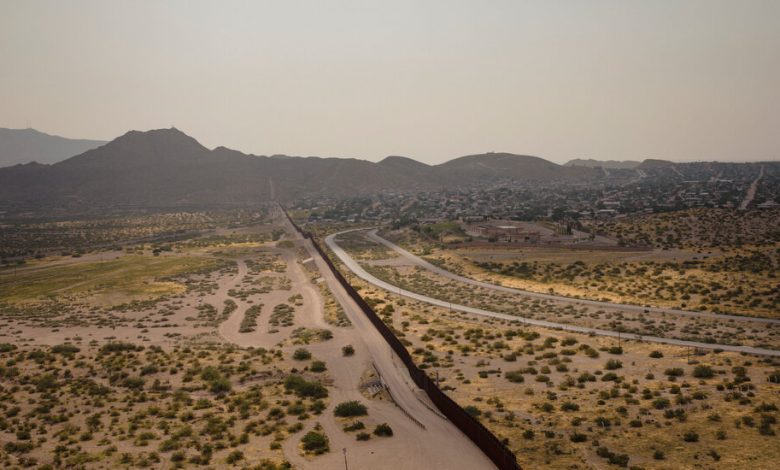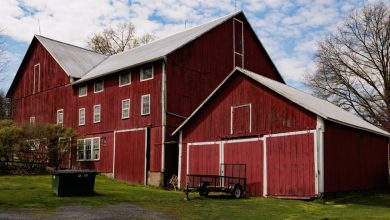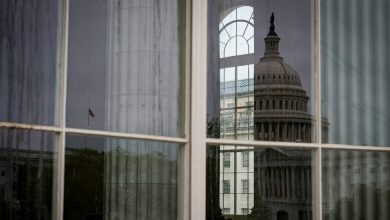Biden, the Border, and Why a New Wall Is Going Up

The Biden administration said on Thursday that it would build up to 20 miles of border barriers authorized during the Trump administration in Texas’s Rio Grande Valley.
The decision is a confusing one. As a candidate, President Biden pledged never to build another foot of border wall. And on Thursday, he told reporters that he did not think the wall would be effective.
While former President Donald J. Trump made the border wall a signature of his immigration policies, he was not the first president to build barriers to keep people from coming to the United States illegally.
Portions of the border wall date back to the 1990s. In 2006, Congress revived the concept and expanded it. As a senator, Mr. Biden supported it. Construction continued throughout the Obama administration, as well. Over the years, wall projects have started and stopped because of environmental and legal issues.
Here’s what you need to know about its latest iteration.
Why is President Biden building the wall?
Alejandro N. Mayorkas, the Homeland Security secretary, says Mr. Biden is building up to 20 miles of border wall because he has to.
The administration said that it was bound to build this section of new wall because Congress already appropriated the funding to do so in 2019. It had been unsuccessful in convincing Congress to rescind the funding, Mr. Mayorkas said.
“From Day 1, this administration has made clear that a border wall is not the answer,” Mr. Mayorkas said on Thursday in Mexico City, after a member of the Mexican news media asked about the apparent reversal. “That remains our position, and our position has never wavered.”
But the justification that Mr. Mayorkas gave in the federal register suggested that the construction along this stretch was needed to stop unauthorized crossings.
“There is presently an acute and immediate need to construct physical barriers and roads in the vicinity of the border of the United States in order to prevent unlawful entries into the United States,” he wrote in the public notice.
The administration also said it was waiving more than 20 federal laws and regulations to allow for the construction of the barriers.
The funding appropriated for this section of barriers is separate from the Defense Department funds that Mr. Trump reprogrammed to build a wall. Mr. Biden halted the use of the reprogrammed defense funds on his first day in office.
Have migrants been crossing the border in the Rio Grande Valley?
Border Patrol agents have made more than two million arrests at the southwest border this year. Some 245,000 of those were in the area of the Rio Grande Valley in Starr County, Texas, where the new fencing will go, according to government data.
It is an area where large groups of migrants often make the crossing together. In a five-day period in July, Border Patrol agents arrested four large groups, 520 migrants in all. Most of the migrants were from Central and South America. Border officials say sending large groups of migrants at once is a common technique used by smugglers. The goal, officials say, is to overwhelm Border Patrol agents in remote areas where resources are stretched thin. Many migrants in this region end up being rescued because of dehydration or other health problems that come from spending hours in the desert.
Starr County has about 66,000 residents and is west of the city of McAllen. It is also home to the Lower Rio Grande Valley National Wildlife Refuge, which follows the Rio Grande along the last 275-mile stretch of the river.
Environmentalists have said that building a barrier with bollards, flood lights and other infrastructure, such as roads, will harm fauna and flora in the wildlife corridor.
The dense brush along the river coupled with the area’s isolation make it an ideal crossing point for migrants. As night falls, smugglers pump inflatable rafts and send dozens, hundreds or more people across the Rio Grande. Many of the migrants wear wristbands, used by the smugglers to identify them by category — single adult, family, unaccompanied child.
Once they have crossed, migrants typically walk a few miles, until they encounter a U.S. Border Patrol vehicle. They surrender, and then await transport to a station for processing by the authorities.

Undocumented migrants lined up against the border fence in Yuma, Ariz., to be processed by the Border Patrol.Credit…Adriana Zehbrauskas for The New York Times
How long is the border wall?
There are currently 706 noncontiguous miles of border wall — which consists of a variety of barriers — along parts of the nearly 2,000-mile border between the United States and Mexico. Building a continuous border wall has never been a realistic option, because the terrain along the border is so different.
There are also natural barriers that slow down crossings the way man-made barriers do. In many areas, the wall or other barriers have been constructed north of the international boundary. This means migrants can cross into the United States, but still remain behind the wall.
Which presidents have added to it?
The first iteration of a border wall intended to stem illegal immigration came in 1993 when President Bill Clinton called for 14 miles of barriers — a three-layer fence — to be constructed between San Diego and Tijuana. At the time, that area had a significant number of illegal crossings.
In 2006, Congress called for at least another 700 miles of barrier construction during the Bush administration. By the end of 2008, the administration announced it had completed nearly 500 miles of fencing.
During the Obama administration, when Mr. Biden was vice president,about 130 additional miles of barriers were added, according to government data.
During the Trump administration, some 458 noncontiguous miles of border barrier were constructed, mostly to replace barriers that had been put in place during previous administrations. In all, according to the Government Accountability Office, only 87 miles of new barriers were added.
It hardly looked like what Mr. Trump had described as he chanted with supporters to “build the wall.” He envisioned a concrete wall, at times with spikes mounted at the top of a steel structure to tear migrants’ flesh if they tried to climb over it. At one point, he suggested painting the wall black, so it would burn the skin of anyone who tried to get past it during the extreme heat of summer.
Does building a wall work?
While Mr. Biden says the wall does not work, his budget requests to Congress say otherwise.
“The border wall system impedes and denies illicit cross-border activity by allowing law enforcement an increased response time and greater opportunity for successful law enforcement resolution,” according to budget documents for the 2023 fiscal year request.
Members of law enforcement who work along the southern border also say portions of the wall are an effective part of the overall strategy to secure the border.
Critics have long said that a wall is not the answer. The construction is expensive, and so are the constant repairs.
Janet Napolitano, a former Arizona governor, once said, “Show me a 50-foot wall and I’ll show you a 51-foot ladder.” Ms. Napolitano later became Homeland Security secretary during the Obama administration and argued for border security to include a range of measures, including technology.
A wall is also dangerous for those who try to climb over it. In May, someone trying to enter the country dropped a 4-year-old boy over the wall. In 2018, a woman was impaled by the metal bars, and another died in 2022 after becoming “ensnared” on the fence.
What has Mr. Biden done differently from Mr. Trump?
The idea of a border wall has always been controversial. Some say it goes against America’s history of being welcome to immigrants. Others want it to signal that people without authorization are not welcome. But Mr. Trump identified himself so closely with the wall that it became more politically charged than ever, and still represents a key part of Republican lawmakers’ strategy to secure the border.
On his first day in office, in January 2021, Mr. Biden halted all border wall construction, a direct reversal of Mr. Trump’s policy. Mr. Trump had ordered that defense funds be reprogrammed to cover additional construction, because Congress refused to appropriate the amount of money that Mr. Trump wanted. When Mr. Biden halted construction funded by the Defense Department, this left portions of the wall in various states of construction, with supplies left abandoned in unfinished sections.
A few months later, the number of illegal crossings started to increase significantly, and Mr. Biden’s border policies, particularly halting wall construction, infuriated Republicans and some law enforcement officials along the southern border.
In some areas, this led to small but significant gaps that became new crossing points for the thousands of people a day who arrived in the United States without authorization and surrendered to Border Patrol agents.
The Biden administration has addressed some of these gaps and made repairs, but until now had not undertaken significant new construction.
Jonathan Swan and Miriam Jordan contributed reporting.




